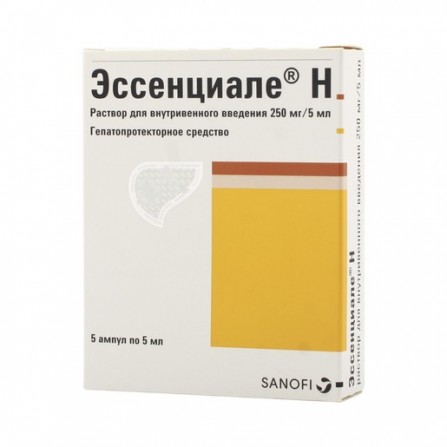Essentiale N solution for intravenous administration of an ampoule 5 ml 5 pcs
Condition: New product
1000 Items
Rating:
Be the first to write a review!

More info
Active ingredients
Phospholipids
Release form
Solution
Composition
Active ingredient: Phospholipids (Phospholipides) Active ingredient concentration (mg): 250
Pharmacological effect
Essential phospholipids are the main elements of the structure of the membrane of cells and cell organelles. In liver diseases there is always damage to the membranes of the liver cells and their organelles, which leads to impaired activity of the associated enzymes and receptor systems, deterioration of the functional activity of the liver cells and reduced ability to regenerate. The phospholipids that make up the preparation correspond to their endogenous chemical structure phospholipids, but surpass endogenous phospholipids in activity due to their higher content of polyunsaturated (essential) fatty acids. Embedding these highly energetic molecules in the damaged areas, the cell membranes of hepatocytes restores the integrity of the liver cells, promotes their regeneration. Cis-double bonds of their polyunsaturated fatty acids prevent the parallel arrangement of hydrocarbon chains in cell membrane phospholipids, the phospholipid structure of cell membranes of hepatocytes is loosened, which causes an increase in their fluidity and elasticity, improves metabolism. The resulting functional blocks increase the activity of enzymes fixed on the membranes and contribute to the normal physiological pathway of the most important metabolic processes. The phospholipids that make up the drug regulate lipoprotein metabolism by transferring neutral fats and cholesterol to the sites of oxidation, mainly due to the increased ability of high-density lipoproteins to bind with cholesterol. Thus, it turns out to be a normalizing effect on the metabolism of lipids and proteins; on the detoxification function of the liver; to restore and preserve the cellular structure of the liver and phospholipid-dependent enzyme systems; which ultimately prevents the formation of connective tissue in the liver. When excretion of phospholipids in the bile there is a decrease in the lithogenic index and stabilization of bile.
Pharmacokinetics
By binding mainly to high-density lipoproteins, phosphatidylcholine enters, in particular, into the cells of the liver. The T1 / 2 of the choline component is 66 hours, and the unsaturated fatty acids - 32 hours.
Indications
Fatty degeneration of the liver (including diabetes mellitus); - acute hepatitis; - chronic hepatitis; - cirrhosis; - liver cell necrosis; - hepatic coma and precoma; - toxic liver damage; - pregnancy toxicosis; postoperative treatment, especially in operations in the hepatobiliary zone; - psoriasis; - radiation syndrome.
Contraindications
Hypersensitivity to the drug; children's age up to 3 years.
Precautionary measures
Do not exceed recommended doses.
Use during pregnancy and lactation
Essentialle N should be used with caution during pregnancy due to the presence of benzyl alcohol in the preparation, which can penetrate the placental barrier (use of drugs containing benzyl alcohol in newborn or preterm infants was associated with the development of dyspnea syndrome ).
Dosage and administration
The drug is intended for intravenous administration, it should not be administered intramuscularly due to possible local irritation reactions. In the absence of other recommendations of the doctor, the drug should be administered slowly in 1-2 ampoules (5-10 ml) or in severe cases 2 -4 ampoules (10-20 ml) / day. The contents of two ampoules can be administered simultaneously. Do not mix in the same syringe with other drugs. It is recommended to dilute the solution with the patient’s blood in a 1: 1 ratio. When a dilution of the drug is necessary, only 5% or 10% dextrose solution is used for infusion, and the diluted solution must remain transparent throughout the entire administration period. Ringer's solution)! It is recommended, as soon as possible, to supplement parenteral administration with oral medication.
Side effects
On the part of the immune system: rarely - due to the content of benzyl alcohol in the formulation, hypersensitivity reactions may develop; very rarely - skin allergic reactions (rash, rash or urticaria); frequency unknown - itching.
Overdose
No data.
Interaction with other drugs
To date, not known.
special instructions
Use only clear solution!




